Last updated: February 9, 2022
Article
Observing Bald Eagles in Cuyahoga Valley
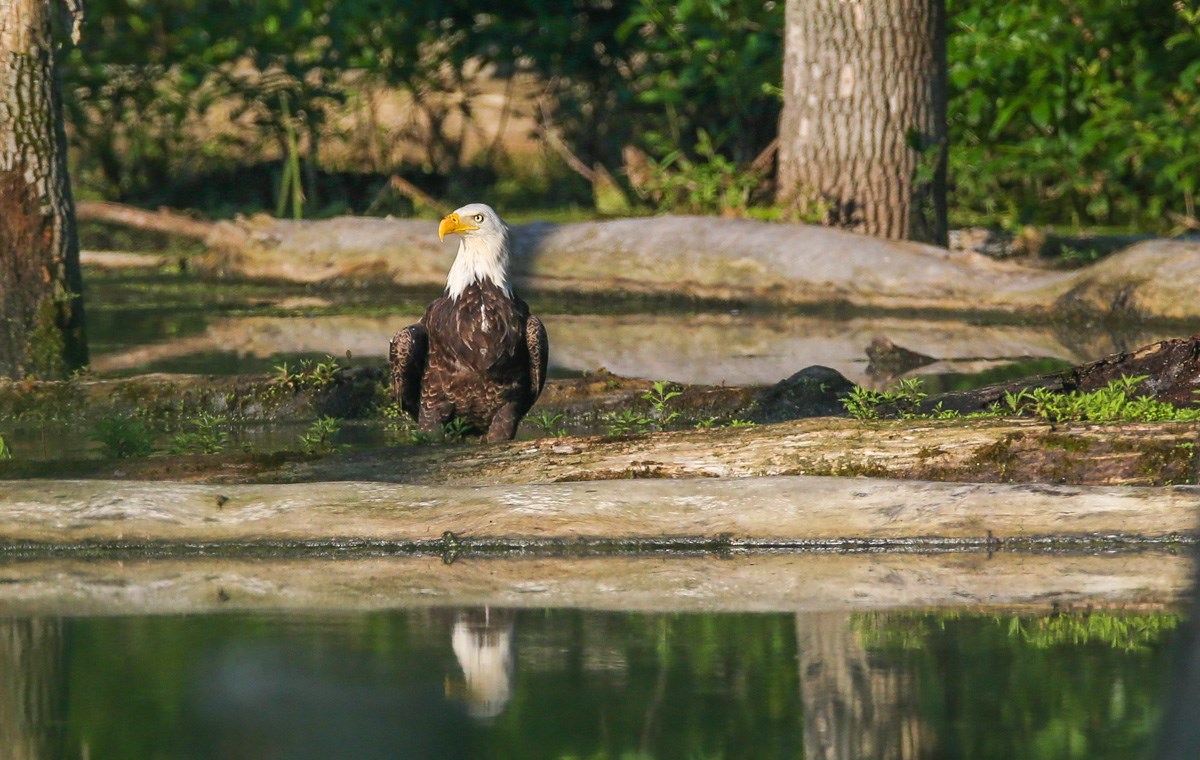
© Rick McMeechan
The best place to see bald eagles within Cuyahoga Valley National Park is in the Station Road Bridge area. There is an active nest in a wetland just north of the State Route 82 bridge. Viewing details are below. Also watch the skies and tall tree perches anytime you are near the Cuyahoga River. Local photographers have captured eagle behavior throughout the year. You might get lucky too.
Identifying Bald Eagles
Adult bald eagles are especially striking, with bright white heads and tails that contrast sharply with their solid brown bodies. Immature eagles lack the white head. Their coloring is uniformly dark brown with bright white on the underside of their wings close to their bodies. It takes five to six years before the birds develop adult plumage. Males and females appear identical in all phases of development. Eagles are 30 to 43 inches in length and have a seven-foot wingspan. They soar with their wings nearly flat, not tilted up like turkey vultures.
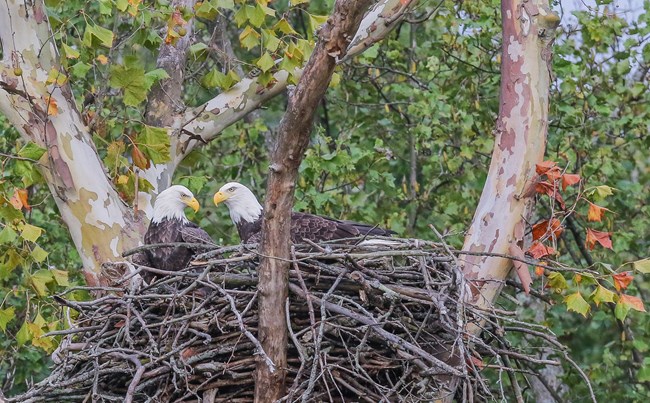
© Rick McMeechan
Courtship and Nesting
Courtship begins in the fall and resumes in late January, when eagles perform amazing aerial displays. The pair plunges through the air in very high dives, locking their talons and breaking apart just when it looks as if they are going to crash to the ground. As outstanding as these displays are, it is believed that nest building is even more critical for establishing bonds.
Bald eagles are monogamous and thought to mate for life. Eagle nests are often found in marshes and swamps, and along rivers throughout Ohio. Typically, nests are located in large trees 50 to 100 feet above the ground and close to water, where the eagles can find ample fish. Eagles will use an existing nest, adding to it until it is an average of three to five feet across and three to six feet deep. It is lined with grass, moss, and sometimes cattails. Some eagle nests can weigh as much as a ton.
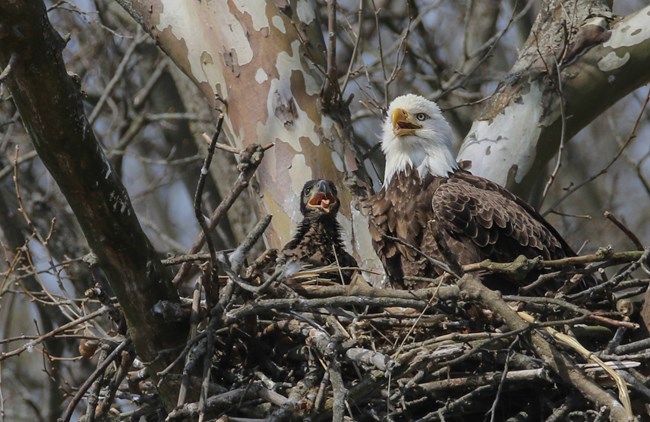
© Rick McMeechan
Incubation and Rearing Young
In late winter, eagles lay one to three (typically two) eggs approximately 36 hours apart to increase the chance that one of the eggs will hatch when conditions are most favorable. The eggs are incubated for approximately 35 days. Eggs hatch over the span of a few days, typically in April or early May. Both parents share the tasks of incubation and rearing young. Eagle eggs and young are extremely sensitive to cold temperatures, so adults must remain on the nest constantly. Human disturbance can disrupt this constant care, jeopardizing nesting success. Young eagles remain in the nest 10 to 12 weeks, until July or early August. For nearly two months after their first flight they will frequently return to the nesting site to receive food from their parents.
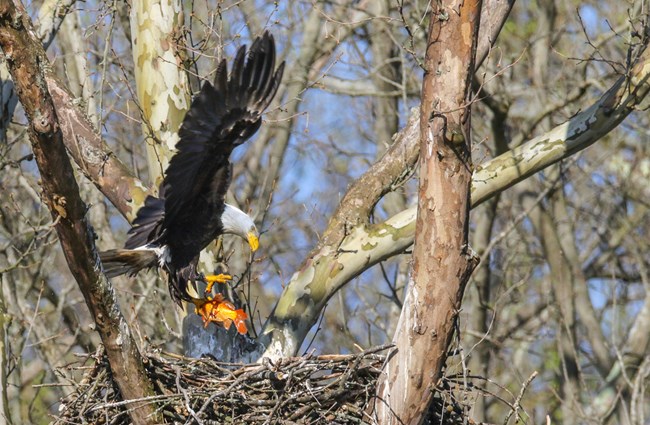
© Rick McMeechan
Finding Food and Taking Flight
As exciting as it is to see an eagle, it is even more thrilling to watch its fishing skill. An eagle, with its incredible eyesight, can see a fish surfacing from up to two miles away, soar over the location, and then grab its prey using its extremely strong four-inch talons. The Cuyahoga Valley eagles are known to forage between Canal Exploration Center and Bath Road along the Cuyahoga River. In winter, they are most commonly seen near open water. Bald eagles prefer to eat fish, but will also eat a variety of small mammals, birds, and sometimes carrion.
Adult bald eagles in Ohio are usually non-migratory and remain close to their nesting area throughout the year. Immature birds migrate sporadically from October through March. Once they are mature enough to breed (after three to four years), they usually nest within 100 miles of where they were born. This behavior, and the continued recovery of the Cuyahoga River valley, suggests a bright future for bald eagles in the national park.
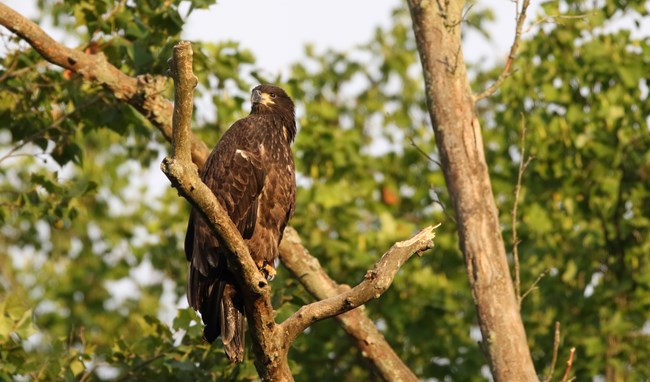
© Rick McMeechan
Observing Nesting Eagles With Care
Eagle pairs can be observed in the Pinery Narrows area north of Station Road Bridge Trailhead or in the southern end of the park near the Beaver Marsh. You can observe the Pinery Narrows nest from the Towpath Trail. Hike past the canal mudcatcher exhibit and look out over the open field to the left. The nest is in the cluster of dead trees across the river.
Nesting eagles are highly sensitive to human foot traffic: please watch quietly using binoculars or a spotting scope from more than 200 yards, obey posted trail restrictions, and stay out of closed areas. Disturbance distracts eagles from sitting on their eggs and can result in breeding failure or abandoning the area as a future nesting site.
You can help protect Cuyahoga Valley’s eagles by observing in ways that ensure their success for years to come. Note that all the photographs on this page were taken in the Cuyahoga Valley, in compliance with rules to protect the nesting eagles.
